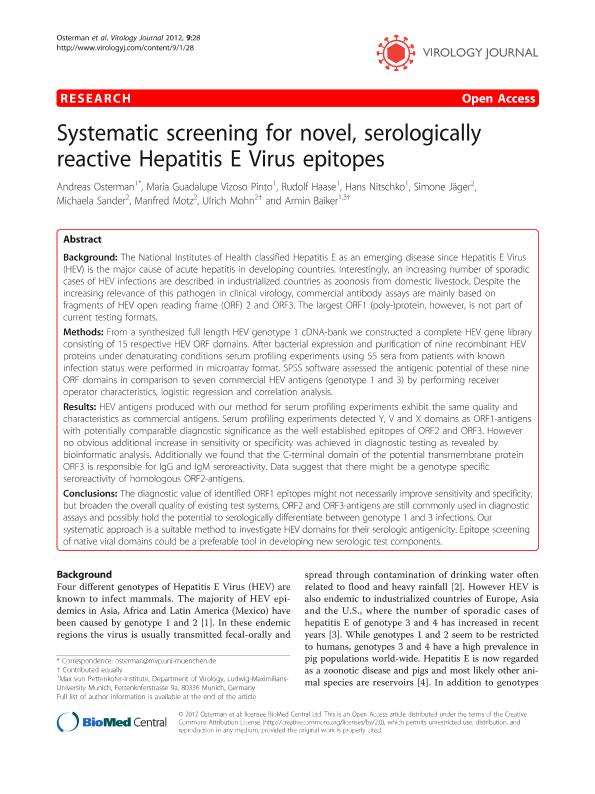Artículo
Systematic screening for novel, serologically reactive Hepatitis e Virus epitopes
Ostermann Porcel, María Victoria ; Vizoso Pinto, María Guadalupe
; Vizoso Pinto, María Guadalupe ; Haase, Rudolf; Nitschko, Hans; Jaeger, Simone; Sander, Michaela; Motz, Manfred; Mohn, Ulrich; Baiker, Armin
; Haase, Rudolf; Nitschko, Hans; Jaeger, Simone; Sander, Michaela; Motz, Manfred; Mohn, Ulrich; Baiker, Armin
 ; Vizoso Pinto, María Guadalupe
; Vizoso Pinto, María Guadalupe ; Haase, Rudolf; Nitschko, Hans; Jaeger, Simone; Sander, Michaela; Motz, Manfred; Mohn, Ulrich; Baiker, Armin
; Haase, Rudolf; Nitschko, Hans; Jaeger, Simone; Sander, Michaela; Motz, Manfred; Mohn, Ulrich; Baiker, Armin
Fecha de publicación:
01/2012
Editorial:
BioMed Central
Revista:
Virology Journal
ISSN:
1743-422X
Idioma:
Inglés
Tipo de recurso:
Artículo publicado
Clasificación temática:
Resumen
Background: The National Institutes of Health classified Hepatitis E as an emerging disease since Hepatitis E Virus (HEV) is the major cause of acute hepatitis in developing countries. Interestingly, an increasing number of sporadic cases of HEV infections are described in industrialized countries as zoonosis from domestic livestock. Despite the increasing relevance of this pathogen in clinical virology, commercial antibody assays are mainly based on fragments of HEV open reading frame (ORF) 2 and ORF3. The largest ORF1 (poly-)protein, however, is not part of current testing formats. Methods. From a synthesized full length HEV genotype 1 cDNA-bank we constructed a complete HEV gene library consisting of 15 respective HEV ORF domains. After bacterial expression and purification of nine recombinant HEV proteins under denaturating conditions serum profiling experiments using 55 sera from patients with known infection status were performed in microarray format. SPSS software assessed the antigenic potential of these nine ORF domains in comparison to seven commercial HEV antigens (genotype 1 and 3) by performing receiver operator characteristics, logistic regression and correlation analysis. Results: HEV antigens produced with our method for serum profiling experiments exhibit the same quality and characteristics as commercial antigens. Serum profiling experiments detected Y, V and X domains as ORF1-antigens with potentially comparable diagnostic significance as the well established epitopes of ORF2 and ORF3. However no obvious additional increase in sensitivity or specificity was achieved in diagnostic testing as revealed by bioinformatic analysis. Additionally we found that the C-terminal domain of the potential transmembrane protein ORF3 is responsible for IgG and IgM seroreactivity. Data suggest that there might be a genotype specific seroreactivity of homologous ORF2-antigens. Conclusions: The diagnostic value of identified ORF1 epitopes might not necessarily improve sensitivity and specificity, but broaden the overall quality of existing test systems. ORF2 and ORF3-antigens are still commonly used in diagnostic assays and possibly hold the potential to serologically differentiate between genotype 1 and 3 infections. Our systematic approach is a suitable method to investigate HEV domains for their serologic antigenicity. Epitope screening of native viral domains could be a preferable tool in developing new serologic test components.
Archivos asociados
Licencia
Identificadores
Colecciones
Articulos(CCT - NOA SUR)
Articulos de CTRO.CIENTIFICO TECNOL.CONICET - NOA SUR
Articulos de CTRO.CIENTIFICO TECNOL.CONICET - NOA SUR
Articulos(INSIBIO)
Articulos de INST.SUP.DE INVEST.BIOLOGICAS
Articulos de INST.SUP.DE INVEST.BIOLOGICAS
Articulos(INTEQUI)
Articulos de INST. DE INVEST. EN TECNOLOGIA QUIMICA
Articulos de INST. DE INVEST. EN TECNOLOGIA QUIMICA
Citación
Ostermann Porcel, María Victoria; Vizoso Pinto, María Guadalupe; Haase, Rudolf; Nitschko, Hans; Jaeger, Simone; et al.; Systematic screening for novel, serologically reactive Hepatitis e Virus epitopes; BioMed Central; Virology Journal; 9; 1-2012; 1-9
Compartir
Altmétricas



